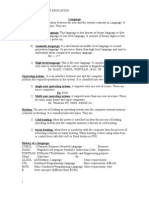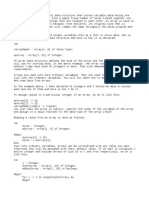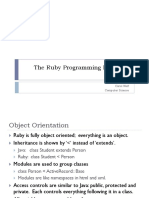C Programming Important Questions: Unit I
Uploaded by
gayathri deepthiC Programming Important Questions: Unit I
Uploaded by
gayathri deepthiC Programming Important Questions
UNIT I:
1. Explain program development cycle
2. Discuss about programming languages
3. List the features of good programming language
4. Flow chart and algorithm to find largest no of three
5. Flow chart and algorithm to find the factorial of given number
6. Explain structure of C
7. Steps involved in executing c program
8. Types of operators in C
9. Formatted input and output statements in C
UNIT –II
1. Decision making and Branching
Ans:
a. Simple if statement(logical if statement)
b. If….else statement
c. Else…if ladder
d. Nested if… else
e. Switch statement
2. Explain looping statements
Ans:
a. While structure
b. Do while structure
c. For ststement
3. Explain break and continue statement
4. Write a c program to find the given word is palindrome or not
5. String Handling functions
Ans:
a. Strlen() d. Strcmp() f. Strupr()
b. Strcpy() e. Strrev() g. Strlwr()
c. Strcat()
6. Explain 1D and 2D array and array processing
Ans:
1D Array 2D Array
array- name [subscript] array- name [subscript1] [subscript2]
declaration : declaration :
datatype array-name[size] datatype array-name[row size][column
size]
eg: int mark[10]
eg: int mark[5][2]
Array initialization: Array initialization:
Static datatype array-name[size] ={list Static datatype array-name[row size]
of values} [column size]={list of values}
Eg: Eg: static int mark[3][2]={1,4,6,3,2,8}
Static int age[3]={10,20,30}
Mark[0][0] Mark[0][1]
Age[0] Age[1] Age[2] 1 4
10 20 30 Mark[1][0] Mark[1][1]
6 3
Mark[2][0] Mark[2][1]
2 8
1D array processing 1D array processing
a. Storing values in arrays(Reading) a. Storing values in arrays(Reading)
b. Retriving the stored b. Retriving the stored values(writing)
values(writing)
UNIT-3
1. Explain built-in functions
a. Math functions <math.h>
sin() cos() tan() exp() sqrt()
ceil() floor() abs() fabs() pow()
b. Console input/output functions<conio.h>
getch() clrscr() wherex() gotoxy()
getche() putch() wherey() deline()
c. Standard input/output functions<stdio.h>
scanf() fprintf() getchar() putc() getw() gets()
printf() fscanf() putchar() getc() putw() fabs()
d. Character oriented functions<ctype.h>
isdigir() isupper() toupper() ispunct()
isalpha() islower() tolower()
e. Graphical functions<graphics.h>
initgraph() line() setfillstyle() rectangle() ellipse()
setcolor() setlinestyle() closegraph() cleardevice()
2. Explain the need of user defined functions
Ans:
a. Reduced complexity c. Easy debugging
b. Reusability d. Extendability
3. What are the types of function call (or) Explain parameter passing methods
Ans:
a. Call by value and cal by reference
4. Explain storage classes
Ans:
a. Automatic variables c. Static variables
b. External variables d. Register variables
5. Explain union with example
6. Explain array within structure within example
7. Explain structure definition with example
8. Explain recursion
UNIT-IV
1. Define pointer and give its advantage
2. Give the relation between pointer and array
3. Describe pointers to pointers
4. Types of memory allocation
a. Static memory allocation
b. Dynamic memory allocation
5. Explain the functions used in Dynamic memory allocation
a. malloc()
b. calloc()
c. realloc()
d. free()
UNIT-V
1. Explain C preprocessor
a. Macro substitution directive
b. File Inclusion Directive
c. Compiler control directive
2. Explain Error handling in files
(i) feof() (ii) ferror()
3. Explain command line argument with example
4. Define a file, how a file is opened and closed.
5. Explain random access files
a. ftell()
b. rewind()
c. fseek()
You might also like
- Bidyanagar, Mahura, Janla, Bhubaneswar - 752 054 (Orissa) : C.V.Raman College of EngineeringNo ratings yetBidyanagar, Mahura, Janla, Bhubaneswar - 752 054 (Orissa) : C.V.Raman College of Engineering5 pages
- PROGRAMMING IN C Syllabus Sage UniversityNo ratings yetPROGRAMMING IN C Syllabus Sage University3 pages
- CSE Computer Science Engineering - Lecture Notes and Study Material For College StudentsNo ratings yetCSE Computer Science Engineering - Lecture Notes and Study Material For College Students1,727 pages
- Common To E&C, EI&C, CS&E, IS&E& MX: Department of Technical EducationNo ratings yetCommon To E&C, EI&C, CS&E, IS&E& MX: Department of Technical Education8 pages
- B.Sc. 1 Semester Computer Science Syllabus Under CBCSNo ratings yetB.Sc. 1 Semester Computer Science Syllabus Under CBCS9 pages
- Part 1 Programming Languages C, C++, PythonNo ratings yetPart 1 Programming Languages C, C++, Python31 pages
- Pointers: Pointers in C Programming - Study MaterialNo ratings yetPointers: Pointers in C Programming - Study Material5 pages
- Sharma, J - Sarin, Ashish-Getting Started With Java Programming Language (2017)No ratings yetSharma, J - Sarin, Ashish-Getting Started With Java Programming Language (2017)332 pages
- PracticalExercises-GeneXus15 Junior N1 02 EngNo ratings yetPracticalExercises-GeneXus15 Junior N1 02 Eng39 pages
- Computer Programming 1 (Ugrd) Created By:Anonymous: ITE 6102 OED Prelims Quiz 1 (8/10)No ratings yetComputer Programming 1 (Ugrd) Created By:Anonymous: ITE 6102 OED Prelims Quiz 1 (8/10)227 pages
- (Ebook) Grokking Simplicity: Taming complex software with functional thinking by Eric Normand ISBN 9781617296208, 1617296201 instant download100% (3)(Ebook) Grokking Simplicity: Taming complex software with functional thinking by Eric Normand ISBN 9781617296208, 1617296201 instant download60 pages
- 1.1. Static Vs Dynamic Memory AllocationNo ratings yet1.1. Static Vs Dynamic Memory Allocation9 pages
- Oop-Java: Class-Object & Scope & Lifetime of Variables & Object Passing, Access Control, Static, ThisNo ratings yetOop-Java: Class-Object & Scope & Lifetime of Variables & Object Passing, Access Control, Static, This78 pages

























































































